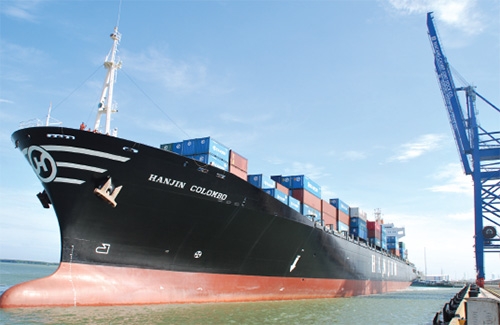Financial storm ravages Cai Mep-Thi Vai ports

The nation’s ports are becalmed as the economy struggles to keep its head above water
SP-SSA International Container Terminal is planning to temporarily close its 38-hectare terminal at the Cai Mep-Thi Vai Port complex.
State-owned Vinalines last week reported this plan to Minister of Transport (MoT) Dinh La Thang. According to Vinalines, the Ba Ria-Vung Tau province-based terminal has to stop operating temporarily because of the cargo shortage at the Cai Mep-Thi Vai port complex, and aiming to avoid bankruptcy. Vinalines reported the joint venture between the US’ SSA Marine, Vinalines and Saigon Port had reached an agreement with bankers to extend debt duration and also exempt interest rates in five years.
The case of SP-SSA International Container Terminal illustrates how terminal operators at the Cai Mep-Thi Vai port complex are in a very perilous condition as they have suffered losses since last year. Five years ago, the construction of terminals in this area was considered as the only way to ease port congestion at ports in neighbouring Ho Chi Minh City. This was planned to replace ports in the second city, and to become the main gateway for import-export operations in the south, the country’s economic hub.
Five terminals were put into operation in the complex including Cai Mep International Terminal, SP-PSA International Port and SP-SSA International Container Terminal, jointly invested by state-run Vinalines and Denmark’s APM Terminals BV, Singapore’s PSA International and US’ SSA Marines, respectively. The other terminals are Saigon New Port’s Tan Cang-Cai Mep Container Terminal and Hutchison Port Holdings’ Saigon International Terminals.
In January this year, the Ministry of Transport (MoT) announced plans to open another container terminal there, namely Cai Mep-Thi Vai International Container Terminal. The new terminal will be under management of Japan’s operator Nippon Yusen Kaisha.
Industry experts warned that the slow pace of terminals’ construction in the Cai Mep-Thi Vai complex would negatively affect economic development of the country as ports in Ho Chi Minh City were facing overloading. None of them at that time could imagine that nowadays port developers in this area have to struggling to survive.
Ngo Minh Tuan, deputy director of Saigon New Port, revealed that all terminals in the Cai Mep-Thi Vai complex last year suffered losses, some up to $30 million per year.
According to the latest report of Ba Ria-Vung Tau Provincial People’s Committee, container terminals in the area are operating at just around 15 per cent of their throughput capacity, that mirrors a dire situation for terminal operators at this time. The cargo volume transported through this complex last year declined 6.5 per cent from 2011, forcing most of the terminals to reluctantly accept bulk cargo to reduce losses.
The reason is that these terminals were built to replace ports in Ho Chi Minh City, such as Saigon Port, Khanh Hoi Port and New Port. However, the second city’s ports have not yet been closed, even though the Vietnamese government has already had this plan for many years.
“We now have to share a pie with terminals in Ho Chi Minh City, which should be closed and relocate to Ba Ria-Vung Tau in accordance with the government’s plan,” said Tran Khanh Sinh, director of Tan Cang-Cai Mep.
Nguyen Xuan Ky, general director at Cai Mep International Terminal, said the existing of too many ports in the south “deformed” port development master plan in the region. Actually, at present, most cargo volume is still handled through ports in Ho Chi Minh City and not through the Cai Mep-Thi Vai port complex. Shipping lines now just maintain seven international direct lines to this port complex.
“There are many reasons for shippers to keep on handling cargo via Ho Chi Minh City’s ports. They have a habit of doing customs procedures at inland clearance depots in southern Binh Duong and Dong Nai provinces while the construction of inland infrastructure linking terminals at the Cai Mep-Thi Vai is at a very slow pace,” Ky said.
Six months ago, Infrastructure Working Group of Vietnam Business Forum, proposed the Vietnamese government to stop opening another container terminal funded by Japanese official development assistance in this area. In addition, it also proposed to “immediately ceasing the licencing of all container terminal building projects in Ho Chi Minh City’s inner parts.”
What the stars mean:
★ Poor ★ ★ Promising ★★★ Good ★★★★ Very good ★★★★★ Exceptional
Latest News
More News
- Vietnam emerging as potential sourcing destination (April 24, 2025 | 16:35)
- MoF unveils reforms to Law on Bidding in draft (April 23, 2025 | 18:23)
- Norway aids green maritime credentials (April 23, 2025 | 16:21)
- Investors from Europe aspire to constructive and open trade (April 23, 2025 | 16:06)
- Investors increase high-tech activities (April 23, 2025 | 15:43)
- Plenty of areas for Vietnam and Thailand to cooperate (April 23, 2025 | 15:37)
- Bac Giang International Logistics Centre launched (April 23, 2025 | 12:02)
- Green engagement rides high in Vietnam (April 22, 2025 | 14:54)
- Public-private partnerships a lever for greener innovation (April 22, 2025 | 14:44)
- Unlock transport potential to accelerate Mekong Delta growth: PM (April 22, 2025 | 11:34)
















 Mobile Version
Mobile Version